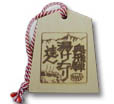Bathers are required to shower and wash thoroughly before entering the hot-spring waters at the facilities, as with all public bathing in Japan. Bathing is nude and separated by gender, although some establishments allow mixed bathing.
Shirahone Onsen
The waters of Shirahone Onsen are milky white due to high levels of calcium and sulfur in the water. Legend states that those who bathe for three days in the waters at Shirahone will not catch a cold for three years. Freshly sourced water, supplied via bamboo spouts installed around the village, can be drunk as is, and consuming it is said to help with gastrointestinal problems.
Norikura Onsen Village
Norikura Onsen Village is located on the Norikura Kogen highlands, and its many hot springs are tapped from three sources. The water sourced from the oldest spring, Norikura Kogen Onsen, is cloudy with a strong smell of sulfur. It also has antibacterial properties and a slightly sour taste, which result from its acidity.
Sawando Onsen
Sawando Onsen was developed in 1998 following the discovery of an underground geothermal spring during construction of the Abo Tunnel, making it one of the newest hot-spring villages in the region. The slightly alkaline waters are very hot, and a free public footbath supplied by the same hot-spring source is located in the center of the village.
Kamikochi Onsen
Famous writers were known to frequent the two hot-spring resorts sitting on the right bank of the Azusa River at Kamikochi. The resorts subsequently are mentioned in several well-known Japanese literary works.
Hirayu Onsen
Forty different sources supply the waters at Hirayu Onsen. Each of these contains a variety of natural minerals with different properties. As a result, the baths in this village all differ depending on the sources they are fed by, and each facility takes pride in its own hot-spring water.
Shin-Hotaka Onsen
Many of Shin-Hotaka’s facilities are located along the Kamata River. The high-temperature waters here are pure and alkaline. Shin-Hotaka Onsen is popular for its many outdoor baths offering views of the surrounding mountains.
See Norikura Onsengo; English Poster on Hot Spring Etiquette - How to Enjoy the "Active and Slow Pace".
 Okuhida Onsenkyo’s Spa Expert's pass ‘Yukemuri Tatsujin‘ program allows visitors to purchase a Spa Expert's Pass ‘Yumeguri Tegata’. The three bathing stickers attached to this 1,200 yen pass can be used to bathe at 2 - 3 of the affiliated hot spring facilities. See this Japanese site about details.
Okuhida Onsenkyo’s Spa Expert's pass ‘Yukemuri Tatsujin‘ program allows visitors to purchase a Spa Expert's Pass ‘Yumeguri Tegata’. The three bathing stickers attached to this 1,200 yen pass can be used to bathe at 2 - 3 of the affiliated hot spring facilities. See this Japanese site about details.
Day-trip bathing may not be possible at hot-springs with accommodation, depending on the season, time of day, accommodation situation, and infectious disease countermeasures. Please check with each facility in advance.





 This mark shows the orign of distance (when sorting by distance) and/or tourist information centers.
This mark shows the orign of distance (when sorting by distance) and/or tourist information centers.